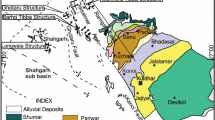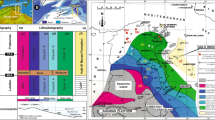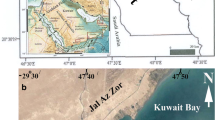Abstract
The role of the micro-facies and diagenesis was assessed to delineate the reservoir potential of the Early Eocene Margalla Hill Limestone, of the Shahdara section. The main focus of the study is the investigation and assessing the quality of the reservoir on the basis of diagenetic and depositional fabrics. Lithologically, the formation grades from thin to medium and massive bedded smaller to larger nodular limestone with sub-ordinate marl and shale inter-beds. Five micro-facies were established based on estimated allo-chemical and ortho-chemical constituent. The enumerated micro-facies include: Planktonic foraminiferal mud-wackestone (MHL-1); Lime mudstone (MHL-2); Lockhartia-rich mud-wackestone (MHL-3); Foraminiferal wackestone (MHL-4) and Bioclastic wackestone (MHL-5). These micro-facies are consistent with the deposition in the proximal outer ramp to proximal inner ramp settings of the gentle-sloping homoclinal ramp environment. The Margalla Hill Limestone is characterized by the fossil assemblages of mainly larger benthic foraminifera, such as Lockhartia, Assilina, Nummulites, rare Operculina, and Rotalia sp., and shallower fauna (echinoderms, algae and miliolids) and a few planktonic foraminifera including Morozovella cf. acuta, Globigerinatheka sp. and other Globogerinids. The fossil assemblages, allo-chemical and micritic constituents signify the depositional change from deep water toward the shallower setting, reflecting a coarsening upward trend during the deposition of the Margalla Hill Limestone. The Margalla Hill Limestone has been subjected to various diagenetic overprints which include micritization, cementation, neomorphism, compactions (mechanical and chemical), dissolution, dolomitization, and micro-calcite-filled fractures, representing early to syn- and post-depositional events. The diagenetic imprints of dissolution, micro-fractures, dolomitization enhance the reservoir characteristics, whereas cementation, micritization, neomorphism and chemical and mechanical compactions adversely affect the reservoir properties of the formation. In the Margalla Hill Limestone, the controlling factors of porosity and permeability distribution are attributed by depositional, diagenetic and deformational processes.













Similar content being viewed by others
References
Abu El Ghar MS, Khalifa MA, Hussein AW (2015) Carbonate diagenesis of the mixed clastic–carbonate Galala formation, north eastern Desert, Egypt. Arab J Geosci 8(5):2551–2565
Abuseda H, Kassab MA, LaLa AM, El Sayed NA (2015) Integrated petrographical and petrophysical studies of some Eocene carbonate rocks, southwest Sinai, Egypt. Egypt J Pet 24(2):213–230
Adabi MH, Zohdi A, Ghabeishavi A et al (2008) Applications of nummulitids and other larger benthic foraminifera in depositional environment and sequence stratigraphy: an example from the Eocene deposits in Zagros Basin, SW Iran. Facies 54:499–512. https://doi.org/10.1007/s10347-008-0151-7Ô
Ahmad S (2011) Paleogene larger benthic foraminiferal stratigraphy and facies distribution: implications for tectonostratigraphic evolution of the Kohat basin, Potwar basin and the Trans Indus Ranges (TIR) northwest Pakistan (Doctoral dissertation, University of Edinburgh)
Ahmad S, Wadood B, Khan S, Ullah A, Mustafa G, Hanif M, Ullah H (2020) The sedimentological and stratigraphical analysis of the Paleocene to Early Eocene Dungan formation, Kirthar fold and thrust belt, Pakistan: implications for reservoir potential. J Sediment Environ 5(4):473–492
Ahmad F, Quasim MA, Ahmad AHM (2021) Microfacies and diagenetic overprints in the limestones of middle Jurassic fort member (Jaisalmer Formation), western Rajasthan, India: implications for the depositional environment, cyclicity, and reservoir quality. Geol J 56(1):130–151
Ahsan N, Chaudhry MN (2008) Geology of Hettangian to middle Eocene rocks of Hazara and Kashmir basins, northwest lesser Himalayas, Pakistan. Geol Bull Panjab Univ 43:131–152
Awais M, Hanif M, Jan IU, Ishaq M, Khan MY (2020) Eocene carbonate microfacies distribution of the Chorgali formation, Gali Jagir, Khair-e-Murat range, Potwar plateau, Pakistan: approach of reservoir potential using outcrop analogue. Arab J Geosci 13(14):1–18
Banerjee S, Khanolkar S, Saraswati PK (2018) Facies and depositional settings of the middle Eocene-Oligocene carbonates in Kutch. Geodin Acta 30(1):119–136
Barattolo F, Bassi D, Romano R (2007) Upper Eocene larger foraminiferal–coralline algal facies from the Klokova mountain (southern continental Greece). Facies 53(3):361–375
Beavington-Penney SJ, Racey A (2004) Ecology of extant nummulitids and other larger benthic foraminifera: applications in palaeoenvironmental analysis. Earth Sci Rev 67(3–4):219–265
Boggs S (2009) Petrology of sedimentary rocks. Cambridge University Press, Cambridge
Brandano M, Frezza V, Tomassetti L, Pedley M, Matteucci R (2009) Facies analysis and palaeoenvironmental interpretation of the late Oligocene Attard member (lower coralline limestone formation). Malta Sedimentol 56(4):1138–1158
Burchette TP, Wright VP (1992) Carbonate ramp depositional systems. Sediment Geol 79(1–4):3–57
Burg JP, Célérier B, Chaudhry NM, Ghazanfar M, Gnehm F, Schnellmann M (2005) Fault analysis and paleostress evolution in large strain regions: methodological and geological discussion of the southeastern Himalayan fold-and-thrust belt in Pakistan. J Asian Earth Sci 24(4):445–467
Corda L, Brandano M (2003) Aphotic zone carbonate production on a Miocene ramp, central Apennines, Italy. Sediment Geol 161(1–2):55–70
Ćosović V, Drobne K, Moro A (2004) Paleoenvironmental model for Eocene foraminiferal limestones of the Adriatic carbonate platform (Istrian Peninsula). Facies 50(1):61–75
Daraei M, Amini A, Ansari M (2015) Facies analysis and depositional environment study of the mixed carbonate–evaporite Asmari formation (Oligo-Miocene) in the sequence stratigraphic framework, NW Zagros, Iran. Carbonates Evaporites 30(3):253–272
Dunham RJ (1962) Classification of carbonate rocks according to depositional texture. In: Ham WE (ed) Classification of carbonate rocks, vol 1. AAPG, Tulsa, pp 108–121
Fahad M, Khan MA, Hussain J, Ahmed A, Yar M (2021) Microfacies analysis, depositional settings and reservoir investigation of Early Eocene Chorgali formation exposed at eastern salt range, upper Indus basin, Pakistan. Carbonates Evaporites 36(3):1–18
Fan TL, Yu BS, Gao ZQ (2007) Characteristics of carbonate sequence stratigraphy and its control on oil-gas in Tarim basin. Geoscience 21(1):57–65
Flügel E (2004) Microfacies of carbonate rocks: analysis, interpretation and application. Springer, Berlin, Heidelberg
Flügel E (2010) Microfacies of carbonate rocks, analysis, interpretation and application, 2nd edn. Springer, Heidelberg, p 984
Garland J, Neilson J, Laubach SE, Whidden KJ (2012) Advances in carbonate exploration and reservoir analysis. Geol Soc, Lond, Special Publ 370(1):1–15
Geel T (2000) Recognition of stratigraphic sequences in carbonate platform and slope deposits: empirical models based on microfacies analysis of Palaeogene deposits in southeastern Spain. Palaeogeogr Palaeoclimatol Palaeoecol 155(3–4):211–238
Grelaud S, Sassi W, de Lamotte DF, Jaswal T, Roure F (2002) Kinematics of eastern salt range and south Potwar basin (Pakistan): a new scenario. Mar Pet Geol 19(9):1127–1139
Hassan HM (2007) Stylolite effect on geochemistry, porosity and permeability: comparison between a limestone and a dolomite sample from Khuff-B reservoir in eastern Saudi Arabia. Arab J Sci Eng 32(2A):139
Heap MJ, Baud P, Reuschlé T, Meredith PG (2014) Stylolites in limestones: barriers to fluid flow? Geology 42(1):51–54
Hottinger L (1997) Shallow benthic foraminiferal assemblages as signals for depth of their deposition and their limitations. Bull De La Société Géologique De France 168(4):491–505
Huaiyou J, Xinmin S, Yuanji W, Xiaoxuan A, Renli Q, Shimi P (2008) Current situation and forecast of the world’s carbonate oil and gas exploration and development. Offshore Oil 28(4):6–13
Hussain J, Khan T, Shami BA, Zafar M, Hayat T (2021) Microfacies analysis and reservoir evaluation based on diagenetic features and log analysis of the Nammal formation, western and central salt range, upper Indus basin, Pakistan. Arab J Geosci 14(11):1–21
Hussein AW, Abd El-Rahman Y (2020) Diagenetic evolution of the Eocene ramp carbonates (a paradigm from the Nile valley, Egypt): petrographical and geochemical attributes. Mar Pet Geol 119:104484
Iannace A, Capuano M, Galluccio L (2011) “Dolomites and dolomites” in Mesozoic platform carbonates of the southern Apennines: geometric distribution, petrography and geochemistry. Palaeogeogr Palaeoclimatol Palaeoecol 310(3–4):324–339
Ishaq M, Jan IU, Hanif M, Awais M (2019) Microfacies and diagenetic studies of the early Eocene Sakesar limestone, Potwar plateau, Pakistan: approach of reservoir evaluation using outcrop analogue. Carbonates Evaporites 34(3):623–656
Jafarian A, Javanbakht M, Koeshidayatullah A, Pimentel N, Salad Hersi O, Yahyaei A and Beigi M (2018) Paleoenvironmental, diagenetic, and eustatic controls on the Permo–Triassic carbonate–evaporite reservoir quality, Upper Dalan and Kangan formations, Lavan Gas Field, Zagros Basin. Geol J 53(4):1442–1457
Jaswal TM, Lillie RJ, Lawrence RD (1997) Structure and evolution of the northern Potwar deformed zone, Pakistan. AAPG Bull 81(2):308–328
Kadri IB (1995) Petroleum geology of Pakistan. Pakistan Petroleum Limited
Kamalifar F, Aleali M, Ahmadi V, Mirzaiee A (2020) Facies distribution, paleoenvironment and sequence stratigraphy model of the Oligo-Miocene Asmari formation (Fars Province, south of Iran). Turkish J Earth Sci 49(4):664–683
Kamran SM, Siddiqi MI (2011) Structural geology and hydrocarbon prospects of the Khairi-Murat area, Potwar sub-basin, Pakistan. Pak J Hydrocarbon Res 21:33–40
Kazmi, A.H. and Rana, R.A., 1982. Tectonic map of Pakistan 1: 2 000 000: Map showing structural features and tectonic stages in Pakistan. Geological survey of Pakistan.
Khalifa MA (2005) Lithofacies, diagenesis and cyclicity of the ‘lower member’of the Khuff formation (late Permian), Al Qasim province, Saudi Arabia. J Asian Earth Sci 25(5):719–734
Khalifa MA, Kumon F, Yoshida K (2009) Calcareous duricrust, Al Qasim province, Saudi Arabia: occurrence and origin. Quatern Int 209(1–2):163–174
Khan Z, Sachan HK, Ahmad AHM, Ghaznavi AA (2020a) Microfacies, diagenesis, and stable isotope analysis of the Jurassic Jumara Dome carbonates, Kachchh, western India: implications for depositional environments and reservoir quality. Geol J 55(1):1041–1061
Khan EU, Saleem M, Naseem AA, Ahmad W, Yaseen M, Khan TU (2020b) Microfacies analysis, diagenetic overprints, geochemistry, and reservoir quality of the Jurassic Samanasuk formation at the Kahi section, Nizampur basin, NW Himalayas, Pakistan. Carbonates Evaporites 35(3):1–17
Khitab U, Umar M, Jamil M (2020) Microfacies, diagenesis and hydrocarbon potential of Eocene carbonate strata in Pakistan. Carbonates Evaporites 35(3):1–15
Koehn D, Rood MP, Beaudoin N, Chung P, Bons PD, Gomez-Rivas E (2016) A new stylolite classification scheme to estimate compaction and local permeability variations. Sed Geol 346:60–71
Lind I, Nykjaer O, Priisholm S, Springer N (1994) Permeability of stylolite-bearing chalk. J Petrol Technol 46(11):986–993
Mahboubi A, Moussavi-Harami R, Carpenter SJ, Aghaei A, Collins LB (2010) Petrographical and geochemical evidences for paragenetic sequence interpretation of diagenesis in mixed siliciclastic–carbonate sediments: Mozduran formation (Upper Jurassic), south of Agh-Darband, NE Iran. Carbonates Evaporites 25(3):231–246
Mehr MK, Adabi MH (2014) Microfacies and geochemical evidence for original aragonite mineralogy of a foraminifera-dominated carbonate ramp system in the late Paleocene to middle Eocene, Alborz basin, Iran. Carbonates Evaporites 29(2):155–175
Mehrabi H, Rahimpour-Bonab H, Enayati-Bidgoli AH, Navidtalab A (2014) Depositional environment and sequence stratigraphy of the upper cretaceous Ilam formation in central and southern parts of the Dezful embayment, SW Iran. Carbonates Evaporites 29(3):263–278
Moghal MA, Saqi MI, Hameed A, Bugti MN (2007) Subsurface geometry of Potwar sub-basin in relation to structuration and entrapment. Pakistan J Hydrocarb Res 17:61–72
Munir MH, Baig MS, Qureshi MA (1997) Lower tertiary litho-biostratigraphy of the Bagla-Kohala-Bala Area, Haripur Hazara (NWFP), Pakistan. Geol Bull, Univ Punjab, p 31–32
Nichols G (2009) Sedimentology and stratigraphy, 2nd edn. Wiley-Blackwell, Oxford, p 419
Pomar L (2001) Types of carbonate platforms: a genetic approach. Basin Res 13(3):313–334
Racey A (1994) Biostratigraphy and palaeobiogeographic significance of Tertiary nummulitids (foraminifera) from northern Oman. Micropalaeont Hydrocarb Explor Middle East 343:370
Rasser MW, Scheibner C, Mutti M (2005) A paleoenvironmental standard section for Early Ilerdian tropical carbonate factories (Corbieres, France; Pyrenees, Spain). Facies 51(1–4):218–232
Read JF, Husinec A, Cangialosi M, Loehn CW, Prtoljan B (2016) Climate controlled, fabric destructive, reflux dolomitization and stabilization via marine-and synorogenic mixed fluids: an example from a large Mesozoic, calcite-sea platform, Croatia. Palaeogeogr Palaeoclimatol Palaeoecol 449:108–126
Romero J, Caus E, Rosell J (2002) A model for the palaeoenvironmental distribution of larger foraminifera based on late middle Eocene deposits on the margin of the south Pyrenean basin (NE Spain). Palaeogeogr Palaeoclimatol Palaeoecol 179(1–2):43–56
Sallam E, Wanas HA, Osman R (2015) Stratigraphy, facies analysis and sequence stratigraphy of the Eocene succession in the Shabrawet area (north Eastern Desert, Egypt): an example for a tectonically influenced inner ramp carbonate platform. Arab J Geosci 8(12):10433–10458
Sarkar S (2017) Microfacies analysis of larger benthic foraminifera-dominated middle Eocene carbonates: a palaeoenvironmental case study from Meghalaya, NE India (Eastern Tethys). Arab J Geosci 10(5):121
Scholle PA, Ulmer-Scholle DS (2003) A color guide to the petrography of carbonate rocks grains textures porosity diagenesis, vol 77. AAPG Memoir, Tulsa. https://doi.org/10.1306/M77973
Shabafrooz R, Mahboubi A, Moussavi-Harami R, Amiri-Bakhtiar H (2013) Facies analysis and sequence stratigraphy of the evaporite bearing Sachun formation at the type locality, south east Zagros basin, Iran. Carbonates Evaporites 28(4):457–474
Shah SMI (2009) Stratigraphy of Pakistan. Mem Geol Surv Pak 22:257–262
Swati MAF, Haneef M, Ahmad S, Naveed Y, Zeb W, Akhtar N, Owais M (2013) Biostratigraphy and depositional environments of the Early Eocene Margalla Hill Limestone, Kohala-Bala area, Haripur, Hazara fold-thrust belt, Pakistan. J Himal Earth Sci 46(2):65
Swati MAF, Haneef M, Ahmad S, Latif K, Naveed Y, Zeb W, Akhtar N, Owais M (2014) Diagenetic analysis of the Early Eocene Margala Hill limestone, Pakistan: a synthesis for thin section porosity. J Himal Earth Sci 47(2):49
Taghavi AA, Mørk A, Emadi MA (2006) Sequence stratigraphically controlled diagenesis governs reservoir quality in the carbonate Dehluran field, southwest Iran. Pet Geosci 12(2):115–126
Tucker ME, Wright VP (2009) Carbonate sedimentology. Wiley, Oxford, p 496
Vincent B, Emmanuel L, Houel P, Loreau J-P (2007) Geodynamic control on carbonate diagenesis: petrographic and isotopic investigation of the upper Jurassic formations of the Paris Basin (France). Sediment Geol 197:267–289
Wanas HA, Shama AA, El-Nahrawy SA (2020) Depositional model and sequence stratigraphy of the Paleocene-lower Eocene succession in the Farafra Oasis, western Desert, Egypt. J Afr Earth Sci 162:103706
Yang L, Yu L, Chen D, Liu K, Yang P, Li X (2020) Effects of dolomitization on porosity during various sedimentation-diagenesis processes in carbonate reservoirs. Minerals 10(6):574
Yasin M, Umar M, Rameez S, Samad R (2017) Biostratigraphy of early eocenemargala hill limestone in the muzaffarabad area (Kashmir Basin, Azad Jammu and Kashmir). Pak J Geol (PJG) 1(2):16–20
Zamagni J, Mutti M, Košir A (2008) Evolution of shallow benthic communities during the late Paleocene–earliest Eocene transition in the northern Tethys (SW Slovenia). Facies 54(1):25
Author information
Authors and Affiliations
Corresponding author
Additional information
Publisher's Note
Springer Nature remains neutral with regard to jurisdictional claims in published maps and institutional affiliations.
Rights and permissions
Springer Nature or its licensor (e.g. a society or other partner) holds exclusive rights to this article under a publishing agreement with the author(s) or other rightsholder(s); author self-archiving of the accepted manuscript version of this article is solely governed by the terms of such publishing agreement and applicable law.
About this article
Cite this article
Aziz, H., Hussain, J., Tariq, M. et al. Sedimentological and diagenetic analysis of Early Eocene Margalla Hill Limestone, Shahdara area, Islamabad, Pakistan: implications for reservoir potential. Carbonates Evaporites 37, 75 (2022). https://doi.org/10.1007/s13146-022-00822-0
Accepted:
Published:
DOI: https://doi.org/10.1007/s13146-022-00822-0




